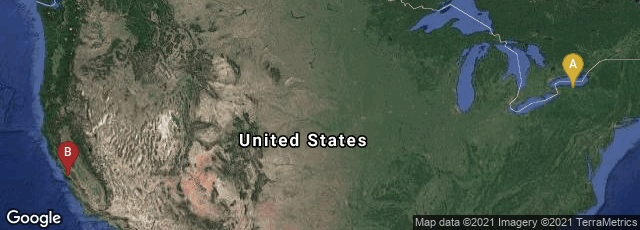
A: Rochester, New York, United States, B: Cupertino, California, United States
Joseph D. Becker of Xerox Corporation, Rochester, New York, Lee Collins (also at Xerox) and Mark Davis of Apple Computer developed a universal character set, the name for which Becker in his report, Unicode 88 issued on August 29, 1988:
"1.1. Abstract
"This document is a draft proposal for the design of an international/multilingual text character coding system, tentatively called Unicode.
"Unicode is intended to address the need for a workable, reliable world text encoding. Unicode could be roughly described as 'wide-body ASCII' that has been stretched to 16 bits to encompass the characters of all the world's living languages. In a properly engineered design, 16 bits per character are more than sufficient for this purpose.
"In the Unicode system, a simple unambiguous fixed-length character encoding is integrated into a coherent overall architecture of text processing. The design aims to be flexible enough to support many disparate (vendor-specific) implementations of text processing software.
"A general scheme for character code allocations is proposed (and materials for making specific individual character code assignments are well at hand), but specific code assignments are not proposed here. Rather, it is hoped that this document will evoke interest from many organizations, which could cooperate in perfecting the design and in determining the final character code assignments" (http://www.unicode.org/history/unicode88.pdf, accessed 01-29-2010).
In October 1991 the first volume of the Unicode standard![]() 1.0 was published by the Unicode Consortium, Mountain View, California.
1.0 was published by the Unicode Consortium, Mountain View, California.
"Unicode is a computing industry standard allowing computers to consistently represent and manipulate text expressed in most of the world's writing systems. Developed in tandem with the Universal Character Set standard and published in book form as The Unicode Standard, the latest version [5.2, 2009] of Unicode consists of a repertoire of more than 107,000 characters covering 90 scripts [including Egyptian hieroglyphs] a set of code charts for visual reference, an encoding methodology and set of standard character encodings, an enumeration of character properties such as upper and lower case, a set of reference data computer files, and a number of related items, such as character properties, rules for normalization, decomposition, collation, rendering, and bidirectional display order (for the correct display of text containing both right-to-left scripts, such as Arabic or Hebrew, and left-to-right scripts) " (Wikipedia article on Unicode, accessed 01-29-2010).